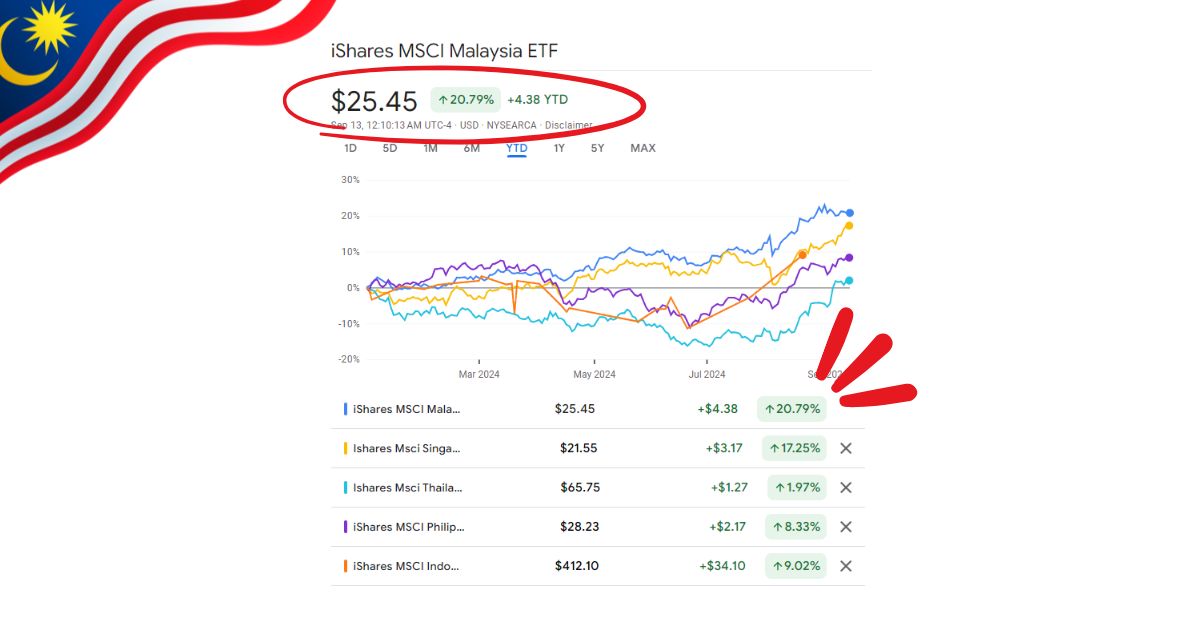Those who know me, know that I am not a fond supporter of the Malaysian stock market when it comes to long-term investing.
However, it is hard to deny that, when looking at the YTD returns of Southeast Asia’s regional ETFs, Malaysia seems to be outperforming its peers by quite a mile.

And to rub more salt in the wound, the iShares MSCI Malaysia ETF (NYSEARCA: EWM) is also outperforming the Vanguard S&P500 ETF (NYSEARCA: VOO).

Before I present my rebuttal and rest my case, let’s dig deeper into why the Malaysia index and overall market are outperforming.
The iShares MSCI ETF components
Malaysia’s top 3 banks – Public Bank Berhad (KLSE: PBB), Malayan Banking Berhad (KLSE: MBB) and CIMB Group Holdings Berhad (KLSE: CIMB) makes up close to 36% of the index.
The key utility and material players that holds relatively large weightage inside the ETF include national power grid Tenaga Nasional Berhad (KLSE: TNB), fellow national gas company Petronas Gas Berhad (KLSE: PETGAS) and its chemical arm Petronas Chemical Group Berhad (KLSE: PCHEM). Local aluminum business Press Metal Aluminium Holdings Berhad (KLSE: PMETAL) is also a notable mention.
The Outperformers and the rally rationale

By taking a look at the outperformers, we can observe a few trends.
The financial sector of the KLCI are mostly the outperformers. The banks YTD rally was in the range of 12-20%, with CIMB chalking a whopping 50%.
Rumors of imminent rate cuts have spurred the Malaysian bank rally, which has been laggards post pandemic, particularly after the US Feds hiked rates to historical highs to counter stubborn hyperinflation.
And with Fed Funds rate higher than the Bank Negara’s Overnight Policy Rate (OPR), it was a no brainer for investors to seek higher interest returns on the world’s strongest and most trusted currency.

Putting everything into the perspective of relativity, we see the Malaysian Ringgit “strengthening” against the USD and SGD.

Simply put or in layman terms, the Ringgit becomes more valuable and stronger. And Malaysian banks, who hold mainly MYR, rode on the Ringgit’s strength.
As for TNB, it has found tailwind as Malaysia became a key hub for data center expansion in the region. Being the only power grid and electricity provider in the country, it is straightforward to pick it as a key benefactor for AI catalysts and prospects.
As for PMETAL and PCHEM, both companies reported better financials due to favorable margins.
So, am I ready to apologize for my views on the Malaysia stock market?
If you have read through my previous writings or even re-read the beginning of this article, you’ll know that I particularly point out how the Malaysia market is not my favorite ground for long-term investing.

If we were to just zoom out to a 5-year timeframe, you can see the outperformance of the S&P500 and even the Straits Time Index.
The recent rally YTD would be beneficial to those seeking to trade on a short to mid-term basis. But looking at the 5-year track record of just +3.2% total returns, you could just be better off parking your funds in a low-risk, interest guaranteed investment.
Don’t get me wrong, there are good investment gems in Malaysia. But those that really qualify for long-term investment horizons could just be less than 20 companies.
I reiterate myself again if you really want me to – if you want good street food, there are abundance of it in Malaysia.
But for long-term investment stocks, there are so much better ones in Singapore and globally.
If you’re looking for more stock ideas, Alvin shares how he finds the best stocks to invest in to grow our Dr Wealth portfolio. Learn more here.

